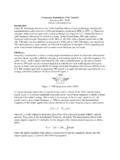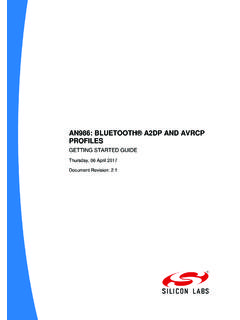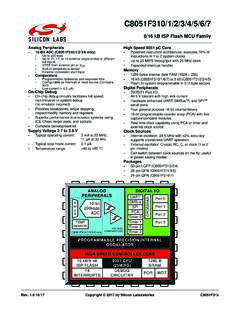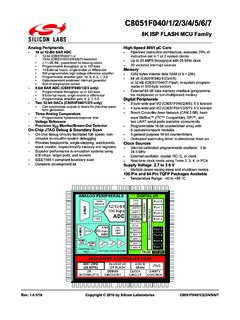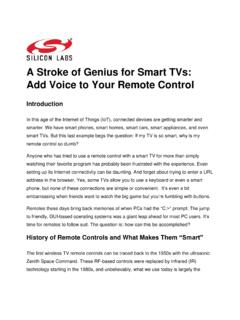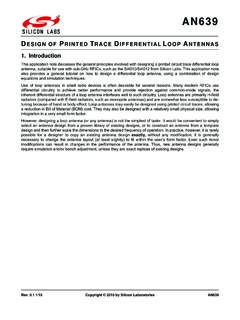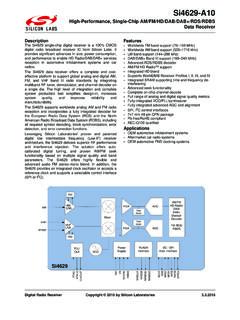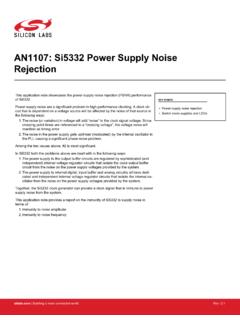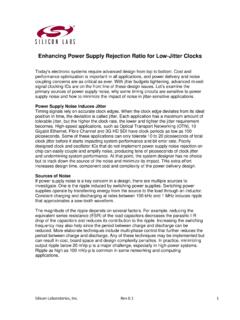Transcription of AN1088: Designing with an Inverted-F 2.4 GHz PCB Antenna
1 an1088 : Designing with an Inverted-F . GHz PCB Antenna This document describes an Inverted-F GHz PCB Antenna designed by Silicon Labs for use with GHz wireless chipset KEY POINTS. designs. The Inverted-F Antenna is one of the more commonly Reference design layout used antennas at GHz. Silicon Labs provides Antenna dimen- Antenna placement and tuning sions in two different substrate thicknesses. PCB antennas are Factors affecting Antenna performance board specific, so you may need to modify the Antenna dimen- sions for your board implementation. | Building a more connected world. Rev.
2 an1088 : Designing with an Inverted-F GHz PCB Antenna Overview 1. Overview One of the main reasons to use a PCB Antenna is to reduce cost. Since the antennas are printed directly on the board, they are gener- ally considered to be free. On boards with room to spare, this will be true. On boards that need to grow to account for the increased size of the printed Antenna , you must include the added cost of the larger PCB when calculating cost savings. Well-implemented PCB antennas will have similar performance to that of a ceramic Antenna . Silicon Labs has released the following Inverted-F based Reference Designs: EM358x USB Ceramic balun with Inverted-F PCB Antenna Reference EM35xx 2-layer Reference design with Ceramic balun and Spiral Inverted-F PCB Antenna EFR32MG, EFR32BG, and EFR32FG GHz radio board designs Note: The details included in this application note are based on four legacy GHz designs.
3 All of the details contained within this document are applicable to EM3x and EFR32 GHz designs. The four legacy GHz designs used to collect the data contained in this document were: EM250 4-Layer design , Inverted-F Antenna , thick ( ). EM250 4-Layer design , Inverted-F Antenna , thick ( ). EM260 4-Layer design , Inverted-F Antenna , thick ( ). EM260 4-Layer design , Inverted-F Antenna , thick ( ). | Building a more connected world. Rev. | 2. an1088 : Designing with an Inverted-F GHz PCB Antenna Layout 2. Layout PCB antennas are very layout sensitive. For best performance, Silicon Labs recommends following the reference design layouts as closely as possible.
4 Key Features Some key features of the design include the following: There are two versions of the layout: for the 62 mil and mm board thicknesses Feed arm should be fed with a 50 ohm microstrip transmission line (14 mils for an top layer). Shorting arm must be shorted to the ground plane, preferably with ground vias There should be no ground plane under the Antenna Ground plane on layers 2 and 4, with stitching vias along the ground edge (however, EFR32 radio boards use ground planes on each layers, where possible). The Antenna was designed to have a 40 mil clearance between the shorting arm and the board edge, and a 20 mil clearance be- tween the board edge and the Antenna trace The Antenna should be covered with soldermask Simulations have shown no benefit to increasing the width of the shorting arm or mitering the bend in the shorting arm The following figure illustrates the dimensions of the Antenna .
5 Figure Antenna Dimensions Note: You may need to modify dimensions for your board's implementation. | Building a more connected world. Rev. | 3. an1088 : Designing with an Inverted-F GHz PCB Antenna Layout Board Stackup The following figure shows the board stackups used in the designs. Figure Board Stackup | Building a more connected world. Rev. | 4. an1088 : Designing with an Inverted-F GHz PCB Antenna Tuning and Antenna 3. Tuning and Antenna Antenna Placement Silicon Labs designed and optimized the Inverted-F reference designs for a 1 -wide PCB board. The ground plane forms an important part of the Antenna .
6 The following figure shows the surface currents around the Antenna . As you can see, there is significant current running along the ground plane edge. Changing the size of the ground plane will affect performance; most notably, the Antenna match will be detuned. For boards that vary in size from the reference design , Silicon Labs recommends the placement shown in the following figure. Figure Surface Current Figure Recommended Antenna Placement | Building a more connected world. Rev. | 5. an1088 : Designing with an Inverted-F GHz PCB Antenna Tuning and Antenna Tuning Silicon Labs designed the printed Antenna to provide a 50-Ohm output.
7 An Inverted-F Antenna can inherently be matched to 50 ohms without using any external tuning component. However, board size, plastic enclosures, metal shielding, and components in close prox- imity to the Antenna can affect Antenna performance. For best performance, the Antenna might require tuning that can be realized by two ways: Dimension changes in the Antenna layout structure, or Applying external tuning components. The latter is typically the preferred solution when layout modification is not required on a custom design . To accomplish this, Silicon Labs generally recommends reserving SMD placeholders for external Antenna tuning components, where the suggested external an- tenna matching structure is a 3-element PI network.
8 You can achieve a good match using a maximum of two elements ( with one series and one shunt component) of the PI network. Any unknown passive impedance can get matched to 50 ohms on this PI network, since all L, C, L-C, C-L combinations can be realized on it and therefore any de-tuning effect can be compensated out. The following figure shows the values of L required for the reference design prototypes. All four designs required C1/C2 to be unpopula- ted. Note that every implementation of the Antenna design will require different combinations of inductors and capacitors. The EM260.
9 Reference design has the printed Inverted-F Antenna inherently matched to 50 ohms. Figure Antenna Matching Components EM250 62 mil: L = nH. EM260 62 mil: L = nH. EM250 : L = nH. EM260 : L = 0 ohm C1, C2 are not populated | Building a more connected world. Rev. | 6. an1088 : Designing with an Inverted-F GHz PCB Antenna Antenna Performance 4. Antenna Performance Silicon Labs designed the antennas using CST Microwave Studio. Antenna gain patterns for two board thicknesses were simulated; the following two figures show this for the 62 mil thick board and for the mm board, respectively.
10 The gain shown is the absolute sum of both polarizations. These figures also show the board orientation. Figure Simulation of Gain Pattern for the 62 mil Antenna | Building a more connected world. Rev. | 7. an1088 : Designing with an Inverted-F GHz PCB Antenna Antenna Performance Figure Simulation of Gain Pattern for the mm Antenna | Building a more connected world. Rev. | 8. an1088 : Designing with an Inverted-F GHz PCB Antenna Antenna Performance Effects of Manufacturing Variations Silicon Labs designed both antennas to have enough excess bandwidth to maintain performance over manufacturing tolerances.
